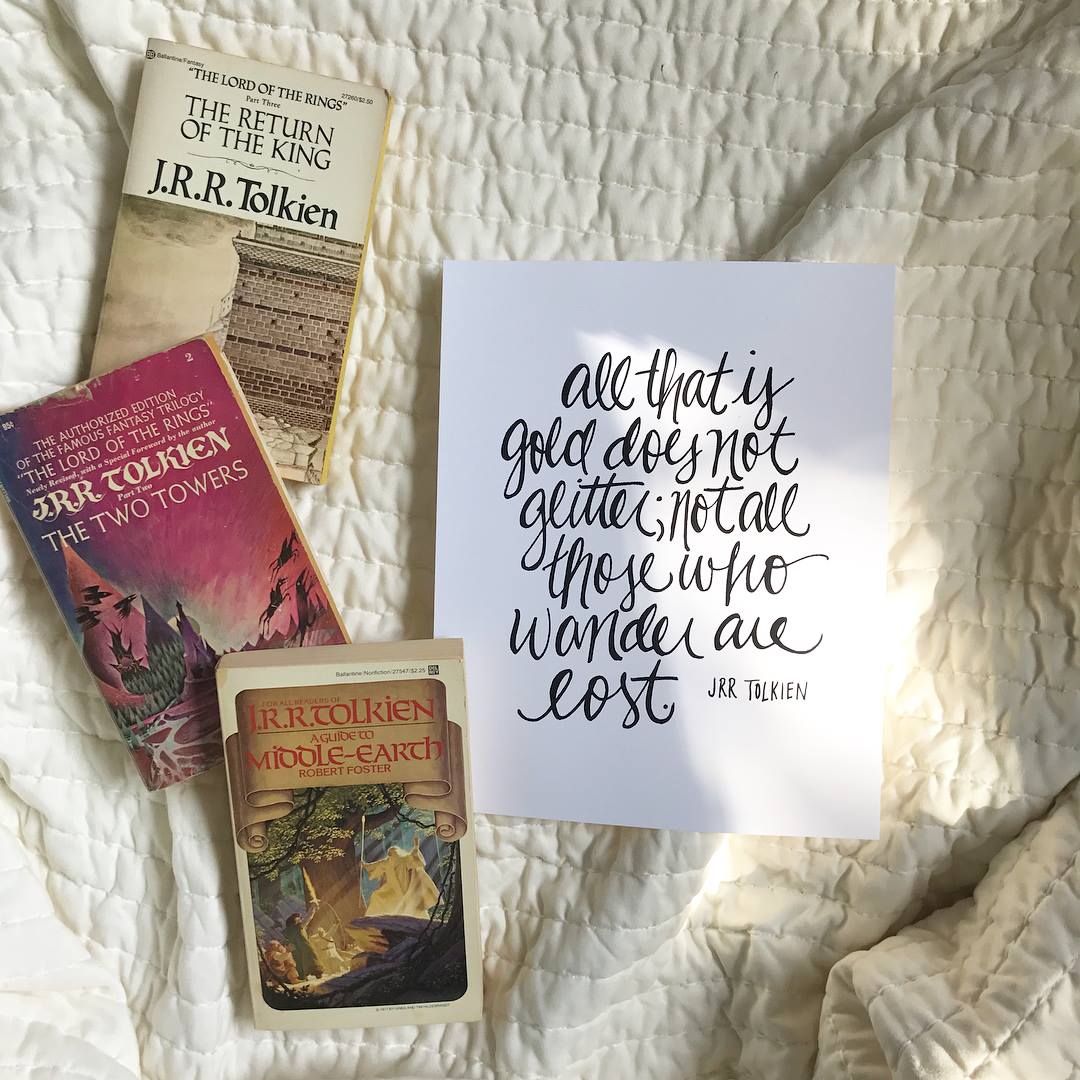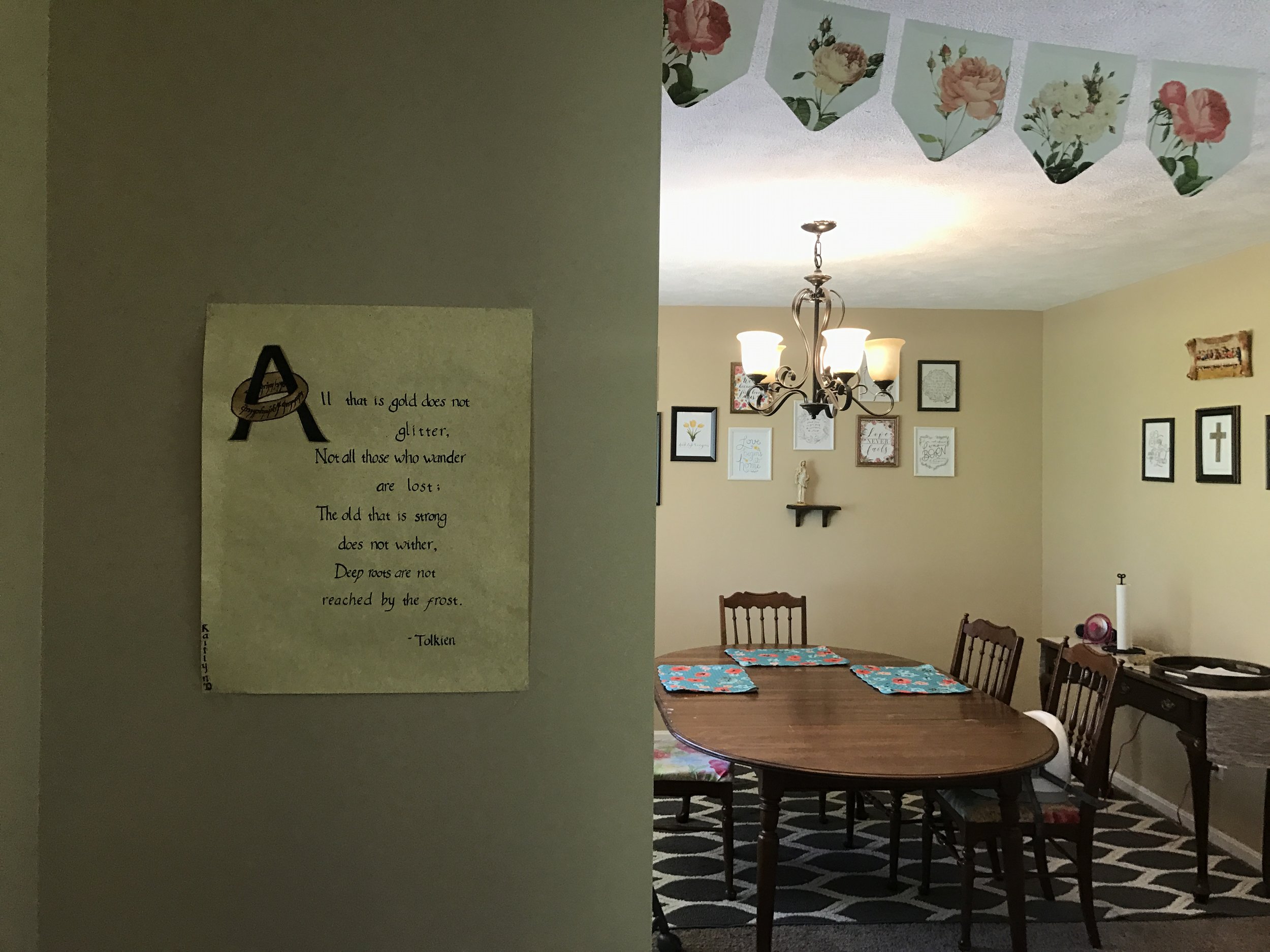All that is gold does not glitter,
Not all those who wander are lost
The old that is strong does not wither,
Deep roots are not reached by the frost.From the ashes a fire shall be woken,
A light from the shadows shall spring;
Renewed shall be blade that was broken,
The crownless again shall be king.-J.R.R Tolkien
Tea with Tolkien is a community inspired by the works and Catholic faith of JRR Tolkien, and I’m so glad you’ve found us. Whether you’ve been here from the very beginning or this is your first time joining us for tea, I hope that you’ll make yourself at home.
This poem contains what is perhaps Tolkien’s most misquoted phrase: Not All Those Who Wander Are Lost. You’ll find lines from it all over t-shirts and inspirational coffee mugs but the ‘those’ from the second line is typically lost. I’m not sure if this is in an attempt to wiggle around the copyright or simply out of ignorance, but either way, it’s a bit frustrating and something that drives Tolkien fans mad.
When I was in high school and had first read The Lord of the Rings, I was a bit obsessed with this poem. In art class, we had a calligraphy assignment in which we were supposed to write out a particular quote and of course I chose this poem. I also mentioned it to my creative writing teacher and she was the first one to mention the way that this poem not only points to Aragorn, but also to Christ.
Let’s begin with a bit of background on the poem itself.
We first hear this poem in Chapter Ten of Book One as Frodo’s reading it in the postscript of a letter from Gandalf. The letter was supposed to have been delivered to Frodo much earlier but was delayed due to the forgetfullness of Mr. Butterbur. The post-post-script reads, “Make sure that it is the real Strider. There are many strange men on the roads. His true name is Aragorn.” And then he includes this poem, apparently meant to be helpful for Frodo in determining who the real Strider is.
“I am Aragorn son of Arathorn; and if by life or death I can save you, I will.”
Aragorn then quotes a part of the poem, “All that is gold does not glitter, not all those who wander are lost”.
‘Did the verses apply to you then?’ asked Frodo. ‘I could not make out what they were about. But how did you know that they were in Gandalf’s letter, if you have never seen it?’
‘I did not know,’ he answered. ‘But I am Aragorn, and those verses go with that name.’ He drew out his sword, and they saw that the blade was indeed broken a foot below the hilt.”
So once the hobbits finally makeit to The Council of Elrond, we hear this poem once again.
Boromir has come to Elrond because of a dream, which he describes as such:
“For on the eve of the sudden assault a dream came to my brother in a troubled sleep; and afterwards a like dream came of to him again, and once to me,
‘In that dream I thought the eastern sky grew dark and there was a growing thunder, but in the West a pale light lingered, and out of it I heard a voice, remote but clear, crying:’
Seek for the Sword that was broken:
In Imladris it dwells;
There shall be counsels taken
Stronger than Morgul-spells.
There shall be shown a token
That Doom is near at hand,
For Isildur's Bane shall waken,
And the Halfling forth shall stand.”
After this, Aragorn stands up and shows Boromir his sword, the Sword that was broken, and then Elrond reveals that Aragorn is a descendant of Isildur and is the Chief of the Dunedain…
Bilbo jumps up and bursts out with the poem again after Boromir is a bit rude to Aragorn.
We also have a few earlier versions of this poem as Tolkien was drafting it. These are recorded within The History of Middle-Earth, in The Treason of Isengard. As far as I’ve been able to learn, this is the original version of the poem:
All that is gold does not glitter
all that is long does not last;
All that is old does not wither;
not all that is over is past.
And then later the last verse was added:
Not all that have fallen are vanquished;
a king may yet be without crown,
A blade that was broken be brandished;
and towers that were strong may fall down.
Tolkien made changes along the way and eventually, apparently, was pleased with the final version we read in The Fellowship of the Ring, and I quite like it myself.
If you want to learn more about the story of Aragorn, you can read a lot about it in Appendix A as well. We had also had high hopes for Amazon’s Middle-earth series to follow the life of “Young Aragorn”, but it doesn’t look like we’ll be getting that after all and it’s probably for the best.
This poem’s primary purpose is of course to give its reader a deeper understanding of Aragorn’s character. He begins this tale as a wandering Ranger, met with scorn and suspicion by many, weatherworn and humble; and yet he will end it as King.
Stepping out of Middle-earth and into what Tolkien referred to as the Greatest Fairy-Story, the Gospel, I think we can see many similarities between Aragorn’s character within this poem and Our Lord and Savior Jesus Christ.
“Not all those who wander are lost” calls to mind an image of Christ wandering in the desert for forty days; “the crownless again shall be King” is reminiscent of Christ’s willingness to live a life of obscurity and sacrifice, the very King of Kings receiving nothing but a crown of thorns as he was mocked and beaten.
I love so much that there isn’t one specific Christ figure in The Lord of the Rings, because it isn’t meant to be read as allegory, yet instead there are several Christ-like characters -- characters that through their own lives of sacrifice and love help us to understand Christ in perhaps a new or different light than we had.
In “The Philosophy of Tolkien”, Peter Kreeft writes,
"There is no one complete, concrete, visible Christ figure in The Lord of the Rings... He is more clearly present in Gandalf, Frodo, and Aragorn, the three Christ figures... They exemplify the Old Testament threefold Messianic symbolism of prophet (Gandalf), priest (Frodo), and king (Aragorn)."
In Philp Ryken’s “The Messiah Comes to Middle-Earth”, Ryken expands on this idea, writing:
“If Gandalf, Frodo, and Aragorn remind us in various ways of Jesus Christ, it is not because the novelist had this explicitly in mind. It is rather because a biblical worldview so thoroughly penetrated his imagination that inevitably it pervaded his literary art."



